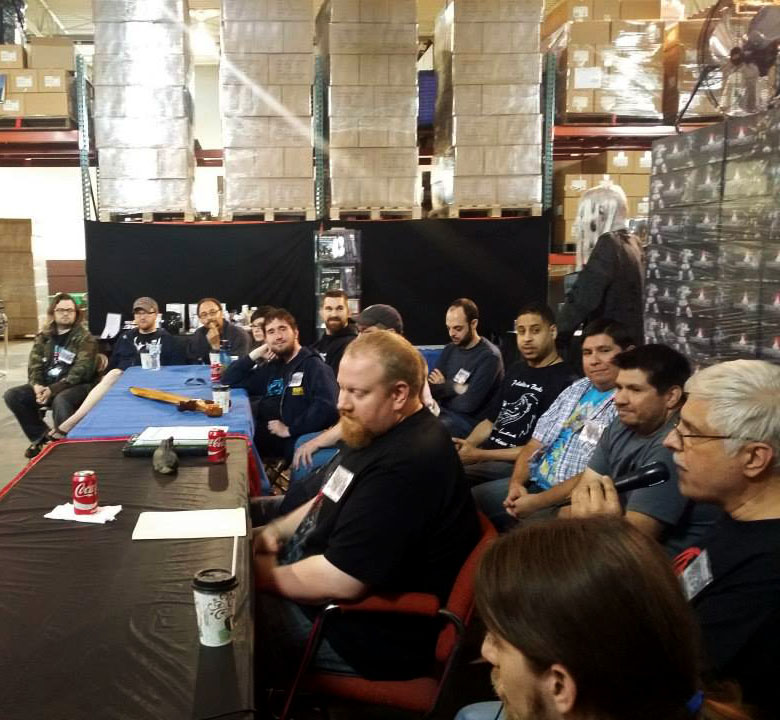Over the years, Palladium Books® has been proven to be a pioneer in game design/storytelling and the use of new technologies in the role-playing market.
Palladium was the first to launch one universal game system starting with The Mechanoid Invasion® in 1981 and followed by The Palladium Fantasy RPG® (1983) and Heroes Unlimited™ (1984). This fact is missed by some people because Palladium Books started out so small and had to slowly build and release its game settings slowly. Nor did we advertise the fact as a marketing angle at first, again, largely because Palladium had a minuscule ad budget and Kevin was learning everything from publishing to marketing as he went along.
World building. Palladium was one of the first game companies to create RPGs with unique and original settings rather than the norm of doing “generic” ones. This started, again, with The Mechanoid Invasion® in 1981 and followed by The Palladium Fantasy RPG® (1983). This approach became abundantly obvious with Teenage Mutant Ninja Turtles® (1985), After the Bomb® (1985), Robotech® (1986), Rifts® (1990) and many other titles. It’s funny, because today, unique world settings is the norm, but back in the 1980s this was the exception. In fact, Palladium had distributors and friends warn against such an unprecedented move right up through the release of Rifts®.
Softbound books. One of Kevin Siembieda’s proudest innovations is one that changed the way the RPG industry packaged product: the softcover book. Palladium was the first to introduce the perfect bound, trade paperback format to the RPG industry. It started with The Palladium Fantasy Role-Playing Game® (1983), but was something Kevin wanted to do from the very start in 1981.
Again, this might seem like an obvious decision today, but in 1983 it was a radical departure from the “boxed game” and “hardcover” book format that was the industry standard. In fact, the idea was so radical that a number of industry people pleaded with Kevin to give up the “crazy idea.” Case in point, Joe Budrick at Windmill Hobbies. Joe was a great guy and a caring (if cantankerous) distributor, so he begged Kevin not to publish the game as a "perfect bound trade paperback." Any departure from the norm, Joe feared, would kill the game and do irreparable damage to Palladium Books. "You have a nice little game company just starting to go places," said Joe, “this will destroy you. Don’t do it.” Kevin greatly appreciated his concern, but the Fantasy game was what he had waited years to publish and in the softbound format.
The game and the format were a success. To his credit, the same distributor called Kevin to congratulate him on a fine product and orders more copies of the RPG. Joe was so impressed, he actually insisted that some of his retail clients take the game on speculation at "his" own risk; something that was rarely done by the RPG "direct market" distributors then or today. God rest his soul, that was the kind of man Joe Budrick was, and he is sorely missed. With rare exception, all of Palladium's books from that year forward have been published as perfect bound, softcover books, even the 48 page titles. To insure that the pages didn't fall out, Kevin took the extra step, time and expense of having the pages sewn and glued, making the books much more durable. The product was slick, colorful, and practical. It also enabled Palladium to hold down printing costs and pass the savings on to the customers. Furthermore, a book (instead of a box) enabled the consumer to look inside and see exactly what he is getting. A winning combination for everybody!
Surprisingly, it took a few years (1985 or 1986) before other role-playing game companies began to use the trade paperback format (we believe Mechwarrior, by FASA was the first). By 1988 it had become an industry standard. Palladium didn't invent the trade paperback, but Palladium's awareness of the (then) new technology gave the company an edge, and in the end transformed the look of the entire RPG industry. We hope to do the same with the new technologies and online mediums of today.
Mixing genres. The art of mixing different genres started for Kevin Siembieda back at the Detroit Gaming Center when people insisted you couldn’t combine magic and technology. Kevin thought that was ridiculous and went about proving the point in his fabled Defilers campaign, which combined the two quite well with amazing results. It would be a theme repeated in the games he’d design and publish at Palladium. Of course, the ultimate mixed genre role-playing game is Rifts®.
Rifts® not only blends magic and technology in a plausible and masterful way, but combines the genres of fantasy, science fiction, horror, post-apocalyptic survival, superheroes, war, mystery and adventure. The setting is epic. The possibilities are endless. Anything is possible. The tenor and emphasis of the adventures you might want to play are left entirely to you and your Game Master. The wealth of World Books, Dimension Books and sourcebooks means gamers can start anywhere, with whatever setting and style of adventure they find most interesting to them. Once they get going, their adventures can remain localized to one or a few areas, or span the infinite Megaverse®.
Dynamic artwork. This was another no-brainer for Kevin. As an artist himself, he wanted to see the quality of RPG art raised to a higher standard. By 1989, Palladium Books and TSR (the D&D publisher) had, arguably, the best art in the business. Palladium also paid some of the best rates, second only to TSR, a company 10 times its size. This led more than one competitor to complain to him about it. One fellow even compared Kevin to George Steinbrenner, owner of the New York Yankees major league baseball team famous for spending more than anyone else on his players, lamenting that Kevin’s practices of paying artists well and using high caliber art were hurting the industry.



